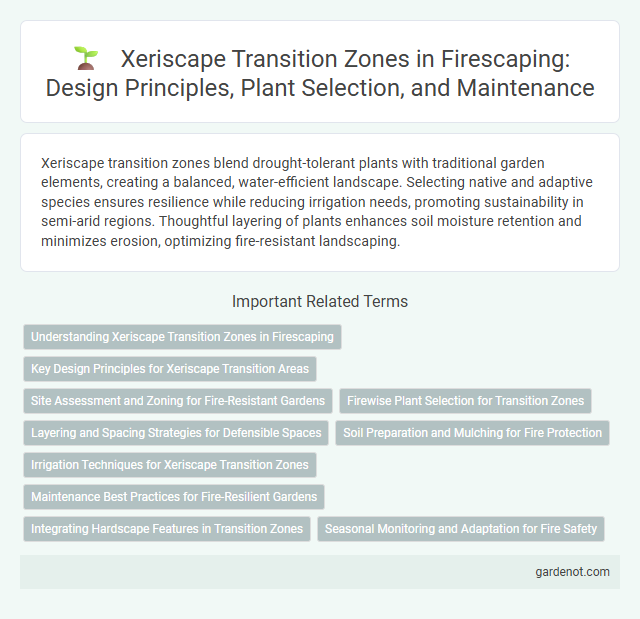Xeriscape transition zones blend drought-tolerant plants with traditional garden elements, creating a balanced, water-efficient landscape. Selecting native and adaptive species ensures resilience while reducing irrigation needs, promoting sustainability in semi-arid regions. Thoughtful layering of plants enhances soil moisture retention and minimizes erosion, optimizing fire-resistant landscaping.
Understanding Xeriscape Transition Zones in Firescaping
Xeriscape transition zones in firescaping involve strategically selecting drought-tolerant, fire-resistant plants that thrive in both arid and semi-arid climates, minimizing wildfire risks. These zones create natural firebreaks by incorporating species like lavender, agave, and ornamental grasses, which reduce flammable vegetation and moisture loss. Proper design in a xeriscape transition zone enhances landscape resilience, conserves water, and supports fire mitigation efforts in vulnerable regions.
Key Design Principles for Xeriscape Transition Areas
Xeriscape transition zones require strategic plant selection emphasizing drought-tolerant native species to reduce irrigation needs and enhance fire resistance. Incorporating fire-resilient materials such as gravel or decomposed granite for ground cover minimizes fuel load and helps create defensible space. Mulching with non-flammable options and maintaining proper plant spacing are critical design principles that support both water conservation and wildfire mitigation in these high-risk areas.
Site Assessment and Zoning for Fire-Resistant Gardens
Site assessment for xeriscape transition zones involves evaluating soil type, slope, and existing vegetation to determine fire risk and water availability. Zoning strategically separates plants based on fire-resistance, with low-flammability species placed near structures and higher-risk vegetation further away. This approach reduces wildfire impact while maintaining an aesthetically pleasing, drought-tolerant landscape that conserves water and enhances property safety.
Firewise Plant Selection for Transition Zones
Firewise plant selection for xeriscape transition zones emphasizes drought-resistant, low-flammability species such as manzanita, California lilac, and ceanothus to reduce wildfire risk while maintaining aesthetic appeal. Incorporating native grasses and succulents like sedum and agave further minimizes fuel loads and water usage in semi-arid climates. Proper plant spacing and maintenance enhance defensible space, creating effective fire breaks in fire-prone landscapes.
Layering and Spacing Strategies for Defensible Spaces
Effective layering and spacing strategies in xeriscape transition zones enhance defensible spaces by reducing fire spread potential. Utilizing fire-resistant plants arranged with adequate horizontal and vertical spacing minimizes fuel continuity while preserving landscape aesthetics. Strategic plant layering incorporates low-flammability species at the ground level, complemented by appropriately spaced shrubs and trees to create fuel breaks and improve fire resilience.
Soil Preparation and Mulching for Fire Protection
Effective soil preparation in xeriscape transition zones involves deep loosening and amending with organic matter to enhance moisture retention while reducing flammable material presence. Applying a thick layer of inorganic mulch, such as gravel or decomposed granite, creates a fire-resistant barrier that minimizes surface heat transfer and inhibits weed growth. Consistent mulching combined with strategic plant placement significantly lowers wildfire impact, promoting fire-safe landscaping tailored for semi-arid climates.
Irrigation Techniques for Xeriscape Transition Zones
Irrigation techniques for xeriscape transition zones emphasize water efficiency by utilizing drip irrigation systems and soaker hoses to deliver moisture directly to plant roots, minimizing evaporation loss. Smart irrigation controllers equipped with soil moisture sensors adjust watering schedules based on real-time environmental conditions, optimizing water use. Mulching around plants further conserves soil moisture and reduces irrigation frequency, essential for sustaining xeriscape landscapes in transition zones.
Maintenance Best Practices for Fire-Resilient Gardens
Maintaining a fire-resilient Xeriscape transition zone requires regular removal of dead plant material and debris to reduce fuel load. Irrigating efficiently and pruning plants to maintain adequate spacing minimizes fire spread risk. Using fire-resistant plant species and mulch further enhances garden safety while conserving water.
Integrating Hardscape Features in Transition Zones
Integrating hardscape features in Xeriscape transition zones enhances fire resistance by creating strategic breaks between vegetation and structures, reducing fuel continuity. Durable materials such as gravel, stone pathways, and concrete patios provide clear defensible spaces that limit fire spread and improve safety. These fire-resistant hardscapes also contribute to aesthetic appeal and water conservation in the xeriscaping design.
Seasonal Monitoring and Adaptation for Fire Safety
Seasonal monitoring in xeriscape transition zones involves regular assessment of plant moisture levels and fuel loads to reduce fire risks. Adaptive management strategies include pruning, removing dead vegetation, and selecting fire-resistant plant species to maintain fire safety. Continuous evaluation ensures xeriscape landscapes remain effective in minimizing wildfire threats throughout changing seasonal conditions.
Xeriscape transition zone Infographic

 gardenot.com
gardenot.com